"It is not a good period when it comes to fresh produce consumption in Italy: between 2017 and 2021, consumption dropped by 9%, i.e. from 6.5 to 5.9 million tons. In particular, 2021 registered a 3% drop compared with 2020. At the same time, the average retail price has been increasing," reported Elisa Macchi, director of CSO Italy, during the Digital Press Lunch of Made in Nature.
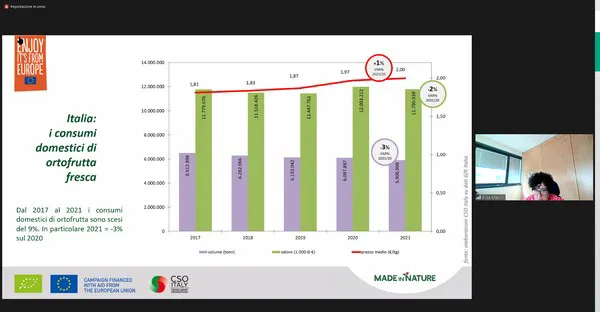
Click here to enlarge the slide, taken from Elisa Macchi's presentation.
When it comes to organic productions, Macchi stressed how "the consumption of organic produce remained rather constant between 2017 and 2019, then there was a first drop in 2020 and another in 2021 (-1% compared to the previous year). Considering the long term between 2017 and 2021, the domestic consumption of organic produce only dropped by 2%. The average retail price increased in this case too."
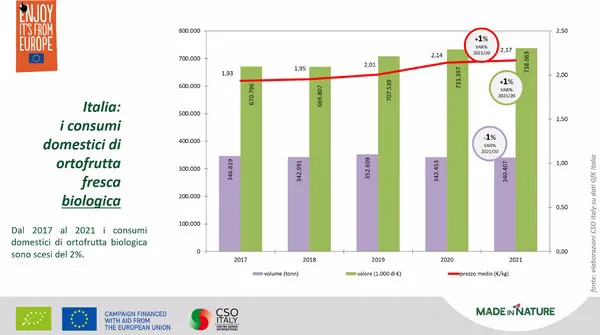
Click here to enlarge the slide, taken from Elisa Macchi's presentation.
Difference between the consumption of organic fruit and vegetable
"The consumption of organic fruit reaches a little over 300 thousand tons, while organic vegetables reach around 38,000 tons. The trend over the years has been different for the two categories. As for fruit, there has been a certain stability between 2017 and 2019 except for a drop in 2018, which became more consistent in 2020 and 2021. As for vegetables, although they represent a smaller share, sales have been increasing year after year: from the almost 24,000 tons of 2017 to the almost 38,000 of 2021."
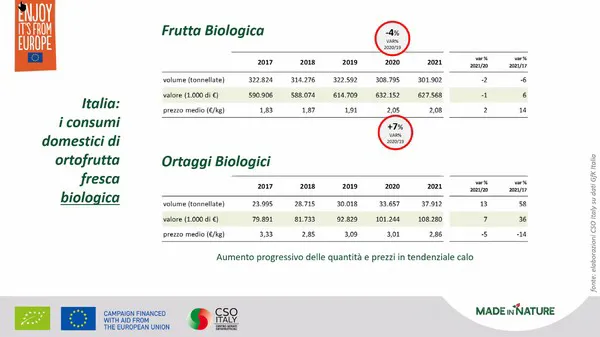
Click here to enlarge the slide, taken from Elisa Macchi's presentation.
"While the average price of fruit has constantly increased during the 5 years taken into consideration, the trend has been dropping for vegetables."
In 2017, fruit represented 93% of the total organic consumption, while it represented 89% in 2021.
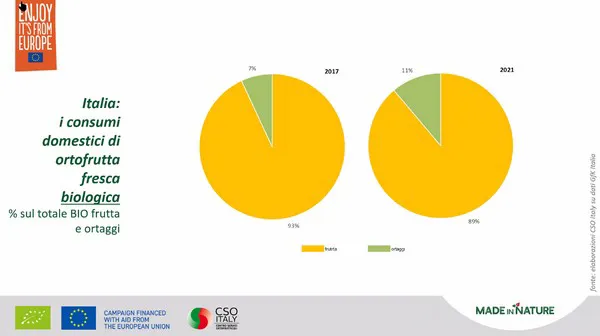
Click here to enlarge the slide, taken from Elisa Macchi's presentation.
"The most popular organic fruits include apples, oranges, bananas (11% each), lemons (9%), and strawberries (7%) which, together, represent almost 50% of organic fruit purchases in our country. In 2021, strawberries and bananas recorded an increase of respectively 34 and 3% compared with 2020, while there was a drop for the other products."
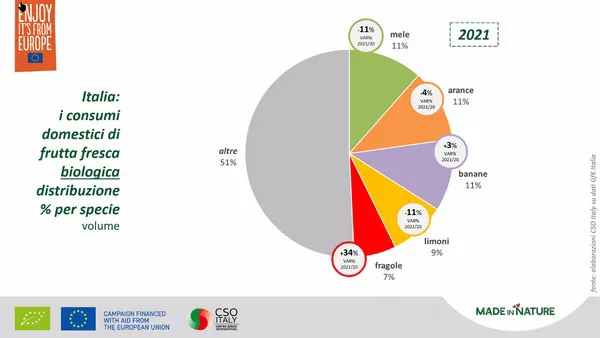
Click here to enlarge the slide, taken from Elisa Macchi's presentation.
If we consider the organic share, the Director of CSO Italy stressed how the ten products considered do not necessarily correspond to those in the chart above. "Lemons occupy the first place with 20%, followed by a series of products such as tangerines, bananas, apricots, cherries, melons and watermelons, whose share of organic produce exceeds 10% of the total. Oranges, clementines and plums hover around 10%."
In addition, Macchi stressed how apples, the most popular product, are not featured in this top-10 because their share of organic produce is below 10%.
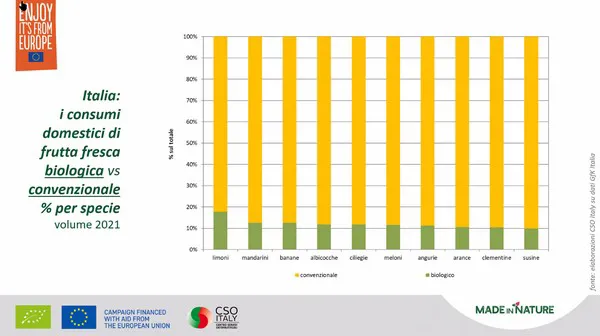
Click here to enlarge the slide, taken from Elisa Macchi's presentation.
"Considering the main vegetable products in detail, 37% of organic purchases in 2021 referred to potatoes, followed by carrots (25%), tomatoes (9%), onions (7%) and zucchini (6%). These 5 products represent over 80% of the domestic consumption of fresh organic vegetables in Italy. Compared with the previous year, potatoes, carrots and zucchini have increased."
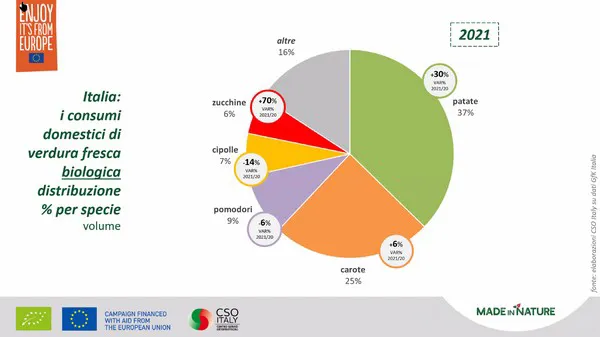
Click here to enlarge the slide, taken from Elisa Macchi's presentation.
Sources of purchases
When it comes to the sources of purchases, there is not much difference between organic and traditional produce in case of big retail chains. Discount stores are less popular (11% vs 17%),to the advantage of specialized stores and stalls.
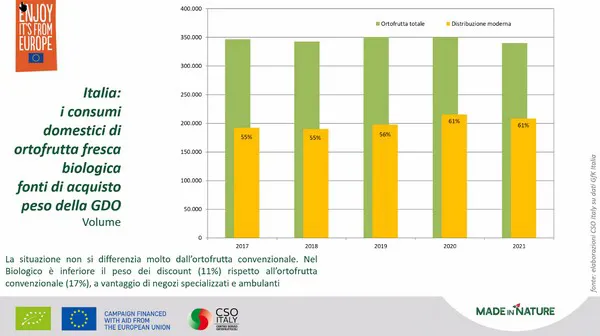
Click here to enlarge the slide, taken from Elisa Macchi's presentation.
"In terms of volumes, supermarkets hold the largest share with a increase in organic sales over the last 5 years. They are followed by markets and specialized greengrocer's and then by discount stores and hypermarkets."
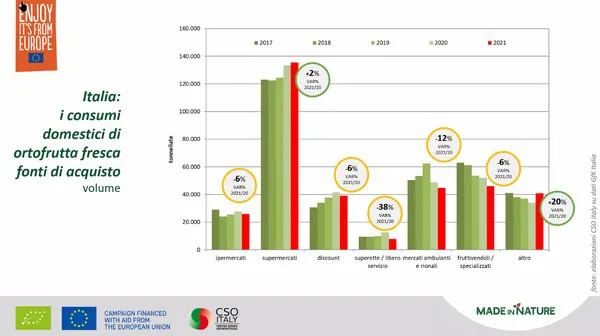
Click here to enlarge the slide, taken from Elisa Macchi's presentation.
The Director of CSO Italy also discussed the average annual price trends for the various sources of purchase "I think it is difficult to detect a relation between average purchase price and organic produce, because the reasons behind a purchase are less linked to prices than in case of traditional produce. For example, discount stores have a lower average price than the other sources of purchase. As for supermarkets, they started with higher average prices, but they are now nearer the average."
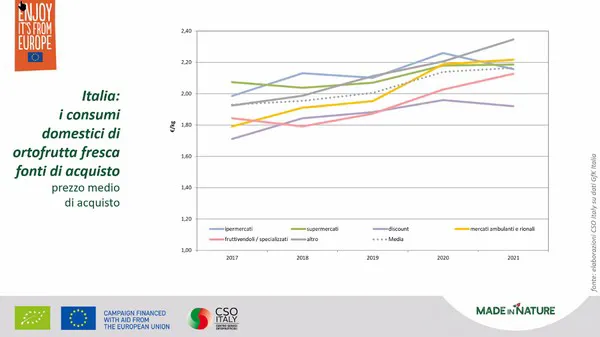
Click here to enlarge the slide, taken from Elisa Macchi's presentation.
Age groups and areas of origin
The families that purchase most organic produce come from north-western Italy, followed by southern Italy (including Sicily), central Italy (including Sardinia) and the north-east.
It is mainly families with one or two components that purchase fresh fruits and vegetables, "though the first registered a 15% drop in 2021 compared with 2020."
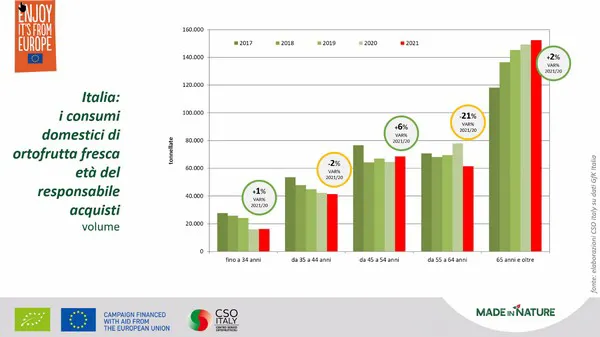
Click here to enlarge the slide, taken from Elisa Macchi's presentation.
"The data concerning the consumption of fresh produce based on the age of those who make the purchase is interesting as well as surprising. As can be seen in the chart above, organic fruits and vegetables are mostly purchased by the over 65s, followed by the 45-54 age group and by the 55-64 age group. Then we have the 35-44 age group and that up to 34 years old."
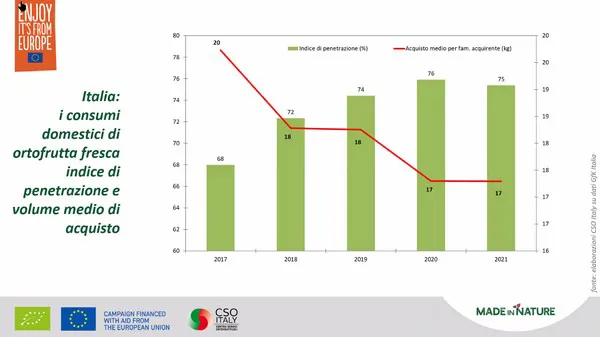 Click here to enlarge the slide, taken from Elisa Macchi's presentation.
Click here to enlarge the slide, taken from Elisa Macchi's presentation.
Finally, Macchi discussed the penetration index and the average purchase volume. "The consumption of organic produce has dropped in Italy over the past two years, but this data is not given by the penetration index, meaning the number of families that purchase organic produce at least once a year has not changed. It is the average consumption per family that has changed: from 20 kg in 2017 to 17 kg in 2021."
